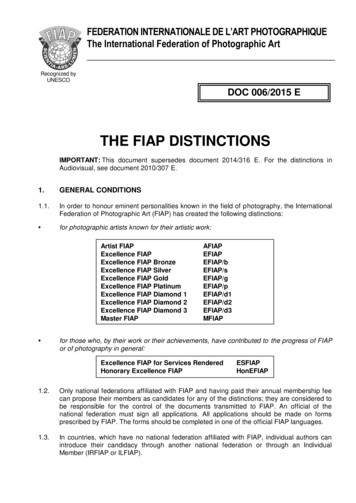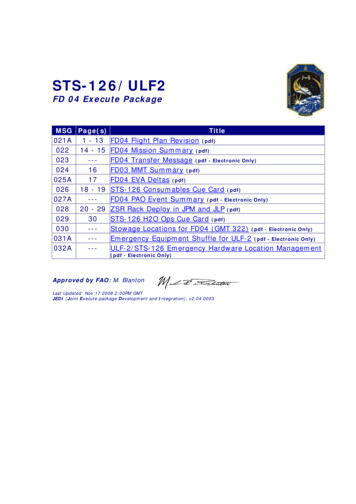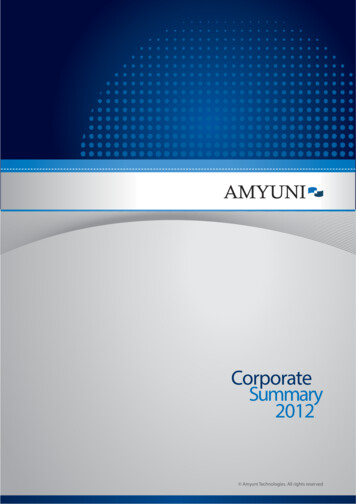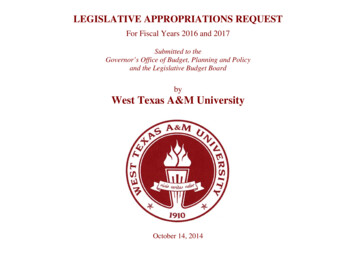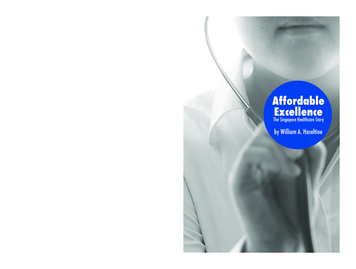
Transcription
WILLIAM A. HASELTINE is President and Founder ofACCESS Health International dedicated to promoting access tohigh-quality affordable healthcare worldwide, and is Presidentof the William A. Haseltine Foundation for Medical Sciencesand the Arts. He was a Professor at Harvard Medical Schooland was the Founder and CEO of Human Genome Sciences.Washington, D.C.www.brookings.edu/pressCover image by Tay Kay ChinCover CS5 .339 spine.indd 1AffordableExcellenceThe Singapore Healthcare Storyby William A. HaseltineBROOKINGSBrookings Institution PressAFFORDABLE EXCELLENCE: THE SINGAPORE HEALTHCARE STORYThe lessons from Singapore will be of interest to those currentlyplanning the future of healthcare in emerging economies, aswell as those engaged in the urgent debates on healthcare inthe wealthier countries faced with serious long-term challengesin healthcare financing. Policymakers, legislators, public healthofficials responsible for healthcare systems planning, financeand operations, as well as those working on healthcare issuesin universities and think tanks should understand how the Singapore system works to achieve affordable excellence.HASELTINEThis is the story of the Singapore healthcare system: how itworks, how it is financed, its history, where it is going, andwhat lessons it may hold for national health systems around theworld. Singapore ranks sixth in the world in healthcare outcomes, yet spends proportionally less on healthcare than anyother high-income country. This is the first book to set outa comprehensive system-level description of healthcare inSingapore, with a view to understanding what can be learnedfrom its unique system design and development path.3/28/13 2:57 PM
Affordable Excellence:The Singapore Healthcare StoryAffordable Excellence combined t1 13/21/2013 7:12:48 PM
Affordable Excellence combined t2 23/21/2013 7:12:48 PM
Affordable Excellence:The Singapore Healthcare StoryHow to Create and Manage Sustainable Healthcare SystemsWilliam A. HaseltineRidge BooksSingaporeBrookings Institution PressWashington, D.C.
ABOUT BROOKINGSThe Brookings Institution is a private nonprofit organization devoted to research,education, and publication on important issues of domestic and foreign policy. Itsprincipal purpose is to bring the highest quality independent research and analysisto bear on current and emerging policy problems. Interpretations or conclusions inBrookings publications should be understood to be solely those of the authors.Copyright 2013William A. HaseltineAll rights reserved. No part of this publication may be reproduced or transmittedin any form or by any means without permission in writing from the BrookingsInstitution Press, except in the case of brief quotations embodied in news articles,critical articles, or reviews.Copublished by Ridge Books, an imprint of National Universityof Singapore Press, and by Brookings Institution PressAffordable Excellence: The Singapore Healthcare Story may be ordered from:Brookings Institution Press1775 Massachusetts Avenue, N.W.Washington, D.C. 20036Telephone: 1-800/537-5487 or 410/516-6956E-mail: hfscustserv@press.jhu.edu; www.brookings.edu/pressLibrary of Congress Cataloging-in-Publication data is availableISBN: 978-0-8157-2416-2 (pbk. : alk. paper)987654321Printed on acid-free paperComposition by ForumKuala Lumpur, MalaysiaPrinted by Versa PressEast Peoria, Illinois
ContentsList of apter 1The Singapore Healthcare System: An Overview1Chapter 2High Quality, Low Cost16Chapter 3Helping Patients Pay38Chapter 4Controlling Costs64Chapter 5Financing83Chapter 6Design and Infrastructure93Chapter 7Investing in the Future through Medical Educationand Research106Chapter 8Facing the 4 Affordable Excellence combined t5 53/21/2013 7:12:49 PM
List of IllustrationsTablesChapter 2Table 2.1Table 2.2Table 2.3Table 2.4Table 2.5Table 2.6Table 2.6aTable 2.7Table 2.8Table 2.8aHealth Indicators, SingaporeLife Expectancy at Birth (years)Infant Mortality Rate (probability of dying byage 1 per 1,000 live births)Under-Five Mortality Rate (probability of dying byage 5 per 1,000 live births)Adult Mortality Rate (probability of dying between15 and 60 years per 1,000 population)Physician Density 2000–2010 (per 10,000 population)and Hospital Beds 2000–2009 (per 10,000 population)Cost Comparisons of Some Major Procedures betweenthe United States and 3 Medical Travel DestinationCountriesHealthcare Costs, SingaporeExpenditures, 2000 and 2008Expenditures, 2000 and 2008171920CPF Contribution and Allocation Rates for theVarious Types of EmployeesCPF Contribution and Allocation Rates for theVarious Types of EmployeesMedisave Withdrawal LimitsTop Up for CPF Medisave Account4022232532343536Chapter 3Table 3.1Table 3.1aTable 3.2Table 3.3414649 iAffordable Excellence combined t6 63/21/2013 7:12:49 PM
List of IllustrationsTable 3.4Table 3.5Table 3.6Table 3.7 iiTax Benefits for Voluntary Contributions byCompanies to Self-Employed Persons’ MedisaveAccountMediShield Yearly PremiumsDeductible and Co-InsurancePremiums for ElderShield40050Annual Premiums for Basic Health Insurancearound the WorldAppendix Surgery (Appendicectomy)Public Hospitals: Medical Specialties66Subsidies at Public Hospitals85545560Chapter 4Table 4.1Table 4.2Table 4.37273Chapter 5Table 5.1Chapter 6Table 6.1Table 6.2Fee Scheme at Ang Mo Kio PolyclinicIntermediate and Long-Term Care (ILTC)Services95102Statistics, Biomedical Industry123Chapter 7Table 7.1FiguresChapter 2Figure 2.1Figure 2.2Figure 2.3Affordable Excellence combined t7 7In-Hospital Case-Fatality Rates within 30 Daysafter Admission for Acute Myocardial Infarction,2007In-Hospital Case-Fatality Rates within 30 Daysafter Admission for Ischemic Stroke, 2007In-Hospital Case-Fatality Rates within 30 Daysafter Admission for Hemorrhagic Stroke, 20072728293/21/2013 7:12:49 PM
iiiList of IllustrationsChapter 3Figure 3.1How MediShield is Utilized to Pay forOne’s Healthcare Bill: Case 1Figure 3.1a How MediShield is Utilized to Pay forOne’s Healthcare Bill: Case 25657Chapter 7Figure 7.1NUS Yong Loo Lin School of Medicine,NUS Faculty of Dentistry, and NUS Alice LeeCentre for Nursing Studies109ChartsChapter 2Chart 2.1Overall Satisfaction of Public Healthcare Institutionsand Willingness to Recommend Public HealthcareInstitutions31Distribution of Medisave Withdrawal48Chapter 3Chart 3.1The author has resolved all copyright issues related to material in this publication.Affordable Excellence combined t8 83/21/2013 7:12:49 PM
AcknowledgmentsThis book was inspired by a speech given in 2010 by then Minister forHealth of Singapore, Khaw Boon Wan, to an international group ofhealth specialists. I had the good fortune to attend the meeting of NIHA(the Initiative to Improve Health in Asia), a Pan-Asian Policy Programsponsored by the National University of Singapore and the Global AsiaInstitute. The Minister’s speech outlined the history and more importantly,the thinking, behind the creation of the Singapore healthcare system. Thesystem he described is both effective and unique. I asked if a book existeddescribing the Singapore approach to healthcare and was surprised to learnthat none did. A few weeks later, I had a follow-up conversation over dinnerwith the NUS President, Tan Chorh Chuan, Director of the Global AsiaInstitute, Seetharam Kallidaikurichi Easwaran, and Paul Kratoska, thenDirector of NUS Press who encouraged me to write this volume. SeetharamKallidaikurichi kindly provided support for a researcher for a year andthe book was on its way. I mentioned that I was writing a volume on theSingapore healthcare system that might provide lessons in the creation ofsustainable healthcare system to others in both developing and developedcountries to Strobe Talbott of the Brookings Institution, and he and hiscolleagues kindly offered to jointly publish the book with NUS Press. Iam grateful to Robert Faherty, Director of the Brookings Press for hisencouragement. I thank Peter Schoppert, now Director of NUS Press, forhis enthusiasm and assistance.I owe special thanks to Claudia Olsson, Managing Director ofACCESS Health International, Singapore for her valuable assistancethroughout. She organized interviews for me, conducted others herself,did much of the research for the final chapter of the book and workedclosely with our researcher, Eti Bhaskar. Eti was tireless in preparingixAffordable Excellence combined t9 93/21/2013 7:12:49 PM
xAcknowledgmentsbackground material for each chapter and tracking down the necessaryinformation. I owe her a deep debt of gratitude.Both the Ministry of Health and the Singapore Economic Development Board were very helpful. The current Minister Gan Kim Yonggraciously allowed us to interview him and his colleagues at the Ministry.Both helped to arrange the numerous interviews with key players in thehealthcare system, both public and private, as well as past and present.Special thanks go to Lee Chien Earn, former Head of the Department ofPublic Health and Deputy Chief Medical Officer of the Ministry of Healthand Lim Eng Kok, Deputy Director (Service Management) of the Ministryof Health, for their continued assistance and help in identifying people anddocuments important for this story. Representatives from the Ministry ofHealth graciously responded to my long series of written questions. I havecited this material and reproduced some of these answers in the Appendixof this volume.I list here many of the people who were kind enough to grant usinterviews, without which we would not have been able to assemble theremarkable story of the Singapore healthcare system past and present. Theywere to a person helpful in all ways and patient in answering our questions.These include: Tan See Leng, Group CEO and Managing Directorof Parkway Pantai Limited; Tan Ser Kiat, Chairman of SingHealthFoundation; Chee Yam Cheng, Group CEO of National Healthcare Group;Yong Ying-I, Previous Permanent Secretary for Health; Yee Ping Yi, CEOof the CPF Board; Sarah Muttitt, former CIO, Information SystemsDivision, MOH Holdings; K. Ranga Rama Krishnan, Dean, Duke-NUSGraduate Medical School; Edward Holmes, A*STAR Executive DeputyChairman, Biomedical Research Council; Phua Kai Hong, AssociateProfessor of Health Policy and Management, Lee Kuan Yew School ofPublic Policy; Chia Kee Seng, Dean, NUS Saw Swee Hock School of PublicHealth; Jason Cheah, CEO, Agency for Integrated Care; Wong LoongMun, Chief Care Integration Officer, Agency for Integrated Care (AIC);C. Frank Starmer, Associate Dean for Learning Technologies, Duke-NUSGraduate Medical School; Lim Chuan Poh, A*STAR Chairman; JohnLim, CEO, Health Sciences Authority; Chua Song Khim, Group CEO ofChina Healthcare Ltd; Anthony Tan, former Director of the HealthcareFinance and Corporate Services of the Ministry of Health; Ang Hak Seng,CEO of the Health Promotion Board; John Wong, former Dean of theNUS Yong Loo Lin School of Medicine; Benjamin Ong, Chief Executiveof the National University Health System; Elizabeth Koh, former GroupDirector (People Matters) and Senior Director (Healthcare LeadershipAffordable Excellence combined t10 103/21/2013 7:12:49 PM
AcknowledgmentsxiDevelopment), Ministry of Health; Elizabeth Quah, Group Director(Planning), Ministry of Health; Peter Lee, former Deputy Director of theLearning Systems Standards & Quality Improvement Division, and theOrganizational Excellence Corporate Human Resource Division, Ministryof Health; David Matchar, Professor and Director, Program in HealthServices and Systems Research, Duke-NUS Graduate Medical School;Tan Yong Seng, Chairman, People’s Association Active Ageing Council;Mary Ann Tsao, President, Tsao Foundation; Susana Concordo Harding,Director, International Longevity Centre Singapore, Tsao Foundation; PhuaPuay Li, Director, Manpower Planning & Strategy Division, Ministry ofHealth; Martyn R. Partridge, Senior Vice Dean, Lee Kong Chian Schoolof Medicine; Lim Siong Guan, Group President, Government of SingaporeInvestment Corporation; Denise Lee, Manager (Clinical Benchmarking),Performance and Technology Assessment Division (PTA), Ministry ofHealth; Kishore Mahbubani, Dean and Professor in the Practice of PublicPolicy of the Lee Kuan Yew School of Public Policy at NUS.Others who provided support and assistance thoughout the researchand writing include: Lee Suet-Fern, Senior Director, Stamford LawCorporation; Min-Tze Lean, Director, Stamford Law Corporation; BernardYeung, Dean at NUS Business School; Sofi Bergkvist, Managing Director,ACCESS Health International; and Priya Anant, CFO, ACCESS HealthInternational.I am grateful to support from ACCESS Health International, a notfor-profit operating foundation dedicated to promoting access to high-qualityand affordable health worldwide, of which I am Chairman and President.The proceeds from this book will be going in their entirety to supportingits work.My thanks also go to my very good friend Ambassador Chan HengChee. Over the many years we have known each other, she has workedtirelessly on behalf of her country. Starting many years ago, she introducedme to key decision-makers in Singapore from all walks of life. She, more thanany other person, is the inspiration for this volume. It is my hope that otherswill find lessons in the Singapore healthcare story and experience to apply intheir own countries to improve the lives and health of their citizens.Finally, I thank Dave Conti for his valuable editorial assistance andconstant input throughout the writing of this book.William A. HaseltineWashington, DC, April 2013Affordable Excellence combined t11 113/21/2013 7:12:49 PM
IntroductionWhy this book? Affordable Excellence tells the story of the Singaporehealthcare system, how it works, how it is financed, its history, and where itis going.Today Singapore ranks sixth in the world in healthcare outcomeswell ahead of many developed countries, including the United States. Theresults are all the more significant as Singapore spends less on healthcarethan any other high-income country, both as measured by fraction of theGross Domestic Product spent on health and by costs per person. Singaporeachieves these results at less than one-fourth the cost of healthcare inthe United States and about half that of Western European countries.Government leaders, presidents and prime ministers, finance ministers andministers of health, policymakers in congress and parliament, public healthofficials responsible for healthcare systems planning, finance and operations,as well as those working on healthcare issues in universities and think-tanksshould know how this system works to achieve affordable excellence.The lessons from Singapore should be of interest to those currentlyplanning the future of healthcare in emerging economies, for Singapore wasnot always rich. In just 50 years, Singapore transformed itself from a lowincome country to one that has one of the highest per capita incomes in theworld, from a country with poor health outcomes to one of the best in theworld. What was the philosophy and what were the key decisions that drovethis transformation? Leaders and policy planners may well ask—will thiswork in my country?One point that emerges clearly: decisions made early on affect thecourse of later history. Once begun, it is very difficult to revise healthfinance and delivery systems, as such decisions profoundly affect the lives ofindividuals and economies. To finance healthcare, should countries adopt axii
Introductionxiiimixture of private and public insurance as does the United States, the stateapproach to healthcare finance and operations as in the United Kingdom,or the public–private partnerships of Germany and Japan? Or should anentirely different approach be taken, that of Singapore, where emphasisis placed on individual responsibility supported by an enabling state?Affordable Excellence describes the Singaporean approach as an alternativewell worth considering.Singapore also offers useful lessons for wealthy countries with longestablished healthcare systems. The world’s most developed countries arefacing a crisis of confidence in their healthcare systems. Costs are rising atan alarming and seemly uncontrollable rate. In the United States, healthcareaccounts for almost 18 percent of the GDP and is rising. Most developedeconomies are facing twin demographic problems: the population of theelderly is rising rapidly and the population of the young, who must supportthem, is shrinking. The cost of caring for the elderly far exceeds that for theyoung. Yet as earning power declines with age, it is not compensated for byincreased earning capacity among the young.The Singapore system offers a guide to controlling costs and payingfor health in the present. It may also provide a blueprint for the future.Singapore is relatively unique amongst governments in its ability to planfor the future. In the past, the government has planned and successfullyexecuted, over a 30-year period, strategies requiring the integration of theactivities of most government ministries. That is how the current healthcaresystem was designed and built. Today, the emphasis is on planning for thecoming demographic crises using the same cross-ministry approach thathas worked so well in the past. How can the current system be adapted toprovide excellent care for the elderly at a cost the country can afford? Thisis the central issue for all developed economies. Those planning for thefuture might well look to Singapore for ideas on how to prepare for thechallenges ahead.I was surprised to learn that no book describing the Singaporehealthcare system has been written. To be sure, aspects of the systemare described in many monographs and books that treat more generaltopics. Affordable Excellence provides a source for those wishing a morecomprehensive knowledge of how the system was built, financed andoperates. In writing this volume, I have often been told that Singapore isunique and lessons learned are not applicable elsewhere. Some say Singaporeis small and solutions to problems there will not work elsewhere. Othersbelieve only a government with a long tenure in power (Singapore’s rulingPeople’s Action Party has been in power since independence in 1965) canAffordable Excellence combined t13 133/21/2013 7:12:50 PM
xi Introductionachieve comparable results. Some even go so far as to describe Singaporeas a dictatorship—an inaccurate characterization in my view—and thatsuch a healthcare system can only be imposed by a controlling government.My answer to these challenges is that I am a scientist trained to look atwhat works. We call working examples “proof of principle.” The Singaporeexperiment does work, proving that healthcare systems can be designed thatprovide high-quality healthcare to all citizens in a highly-developed economyat a cost the economy can afford, and that costs can be controlled whiledelivering excellent service. True, the continuity and long-term perspectivethat come from political stability may make it easier for a government todevelop a strong healthcare system (see next chapter); nonetheless, Singaporehas much to teach health systems no matter what their political context.Affordable Excellence combined t14 143/21/2013 7:12:50 PM
The Singapore Healthcare System CHAPTER 1The Singapore Healthcare System:An OverviewSingapore has achieved extraordinary results both in the high quality ofits healthcare system and in controlling the cost of care. In per capitaterms and as a percentage of Gross Domestic Product (GDP), its healthcare expenditures are the lowest of all the high-income countries inthe world.How did this happen? How has Singapore been able to achieve thesekinds of results?The answers are bigger than just the process of putting a healthcaresystem together. There are larger factors that have to do with the spirit andphilosophy of Singapore itself, the way it is governed, how the governmentapproaches domestic issues, and how it deals with the world.In my study of Singapore, I have found three compelling qualitieswoven into the fabric of the country that have enabled it to achieveoutstanding successes in so many areas, healthcare included. They are longterm political unity, the ability to recognize and establish national priorities,and the consistent desire for collective well-being and social harmony ofthe country.Political Unity and Constancy of PurposeFrom the time the British withdrew from Singapore and left its formercolony to fend for itself, Singapore has been able to develop and grow asan integrated whole. The People’s Action Party (PAP) has been in powersince independence, resulting in sustained political stability. Along withstability has come a unity and constancy of purpose and action throughout Affordable Excellence combined t1 13/21/2013 7:12:50 PM
Affordable Excellencegovernment. Contrast this condition with other countries where governmentregularly changes hands and different parties espousing different agendas goin and out of power. A clear and uninterrupted approach to solving a nation’sproblems is very difficult to achieve in such situations. The government hasbeen steady in its broad general vision of what care should be and what roleit should play in the lives of Singaporeans. That continuity of philosophy andapproach, I believe, has made possible the ability to plan and execute over along period of time.I have also observed an unusual degree of unity among the country’svarious ministries—an acknowledged spirit of cooperation among governmental departments that makes possible the formulation of policiesthat reaches across ministries. A member of the team that assembledthe 1983 health plan discussed in this chapter and Health Ministerfrom 2004 to 2011, Mr. Khaw Boon Wan, has noted that each month,Permanent Secretaries of each ministry meet to focus on issues thatrequire participation by more than one ministry.1 It is simply assumedthat ministers will work as a team on issues that need interdepartmentalcooperation.I find it relevant that the government realized early on that improvement in health conditions and care had to be approached as an integraland inseparable part of the overall development planning for the country.As a heavily urbanized city-state with a population of two million atindependence, caring for the health of the people meant more than justbuilding hospitals and clinics. Health would be affected by almost everyaspect of life in an urban setting: housing, water supply, food supply, airquality, waste disposal, road traffic, parks, tree planting, and more. Ensuringthe health of the people of Singapore had to be built into every aspect ofurban planning, requiring a comprehensive approach and the cooperation ofnumerous ministries over all the various sectors of government. The cultureof cooperation made it all possible.Some have suggested that Singapore is a thinly-disguised dictatorship,and that political stability is attained at the cost of democratic freedom. Thatis simply not the case. Although one party, the PAP, has been in power sinceindependence, it is elected and does not hold power through force, and couldnot have maintained its rule without being highly responsive to the concernsof the electorate.The government is responsive to the concerns of the electorate. In the2011 elections, healthcare was one of the issues raised. There were concernsthat the government was not doing enough for the elderly and that familieswere experiencing severe financial strain and even bankruptcy as they tried toAffordable Excellence combined t2 23/21/2013 7:12:50 PM
The Singapore Healthcare System pay for older family members’ care. Opposition parties organized themselvesaround issues of healthcare affordability and eldercare costs.Early the following year, the government responded with a newprogram of increased spending—doubling the Ministry of Health’s budgetover the next five years—to address citizens’ concerns. It announced increasedsubsidies for long-term care, even for patients being cared for in the home,and expanded eligibilities for subsidies, giving middle-income familiessome financial relief. Subsidies were increased for nursing homes (includingeligible patients in private nursing homes), day care, rehabilitation care, andhome-based care. These actions by the government seem to me to be a directresponse to the issues raised in the elections.Establishing PrioritiesThe health of the populace was not a top priority for the government atthe start of independence. As Lee Kuan Yew observed in his memoirs,he had three immediate concerns to deal with: international recognitionfor Singapore’s independence; a strong defense program that would“defend this piece of real estate”; and finally the economy—“how tomake a living for our people.”2 Yong Nyuk Lin, the Minister for Healthat the time, stated the situation bluntly: “health would rank, at the most,fifth in order of priority” for public funds. National security, job creation,housing, and education were in the queue ahead of health, in that order.3With the exception of the basics of public health, healthcare planningand development would have to wait until the nation achieved a level ofmilitary and economic stability.It seems to me that this ordering of priorities was apt for the time,as it was vitally important first to set up the defense of this small nation,and then to attract investors to set in motion economic growth, and tackleglaring issues of unemployment, housing, and education. After these criticalproblems had been dealt with, others, including healthcare, could be takenon. Exactly where health comes in the priorities of an emerging economymay vary. In countries where HIV/AIDS is highly prevalent, or if anotherepidemic or disease threatens a broad segment of the population, health maybecome the first or second national priority.Wisely, the initial focus in Singapore was on public health: puttingproper sanitation procedures in place, controlling infectious diseases, allsuccessful efforts. Early initiatives were launched to provide clean water,develop a vaccination program, and guarantee access to basic medications,clean food, and more.Affordable Excellence combined t3 33/21/2013 7:12:50 PM
Affordable ExcellenceIn time, the priorities set by the government proved to be effective. Thesecurity situation stabilized and the economy grew to the benefit of all. Thecreation of the healthcare system was aided immeasurably by the outstandinggrowth. One important indicator to consider: GDP grew from just underS 8.5 billion in 1964, to over S 50 billion in 1983 (the year the governmentissued its White Paper declaring its healthcare goals and which I will bediscussing below), to almost S 300 billion in 2011.4 Those economic gainswere successfully translated into raising the health standards of the nationand building the care system that is the subject of this book.Promoting a Sense of Collective Well-Being and Social HarmonyOne of the most important tenets of Singaporean governance is that a strongsociety requires social harmony. If tensions between social groups and racesare to be avoided, all groups should be included in the life of the country andshould benefit, to some degree, from its successes. The government’s actionson behalf of this belief have undergirded the building of modern Singapore.As part of the social fabric, the government built a system that promotes asense of fairness and well-being through both economic opportunity anddelivery of social services. I find these words of Lee key to understandingSingapore’s approach:A competitive, winner-takes-all society, like colonial Hong Kong inthe 1960s, would not be acceptable in Singapore To even out theextreme results of free-market competition, we had to redistribute thenational income through subsidies on things that improved the earningpower of citizens, such as education. Housing and public health werealso obviously desirable. But finding the correct solutions for personalmedical care, pensions, or retirement benefits was not easy.5One important solution Lee and his ministers found was the CentralProvident Fund (CPF). It was set up during British colonial rule as acompulsory savings program for workers to build a nest egg for retirement.Individuals put five percent of their wages into the fund and their employersmatched it. The accumulated money could be withdrawn at age 55. Lee’sgovernment expanded the program, upping the contribution levels, andallowing funds to be used for home-buying (widespread home ownershipwas seen as vital for political and social stability).6The CPF has become one of the key pillars supporting social stability.The government had a long-range vision to increase the use of the Fund overtime and broaden it to allow individuals to save for and pay for education andAffordable Excellence combined t4 43/21/2013 7:12:50 PM
The Singapore Healthcare System healthcare as well as retirement and home-buying. Mandatory contributionrates have risen over the years and now stand at 16 percent of wage foremployers and 20 percent for employees. After age 50, the rates decrease.The Central Provident Fund’s contribution to the viability of thehealthcare system cannot be overstated: it helps control costs by instilling inpatients a sense of responsibility about their spending—after all, it is theirmoney to save or spend; and it helps make care available and affordable toall. Eventually, however, the government recognized that the health savingsprogram would not be enough to support care, and other systems were putin place, including a medical insurance program and a social safety net.Respect and Education for WomenSingapore has been a pioneer in the area of women’s equality beginning withThe Women’s Charter of 1961 that improved the rights and protections ofwomen under law. Singapo
List of Illustrations Tables Chapter 2 Table 2.1 Health Indicators, Singapore 17 Table 2.2 Life Expectancy at Birth (years) 19 Ta


